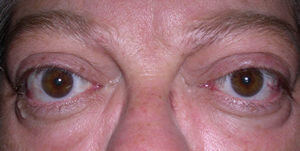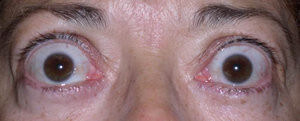![]()
Tampa
(813) 971-3846
![]()
Tampa
(813) 971-3846
 Graves’ disease, a condition in which the thyroid gland is hyperactive, is rarely a life-threatening condition. Although Graves’ disease may develop at any age and in either sex, it most often affects women 20 to 60 years old. The disease can affect the thyroid gland, eyes, and skin. Unfortunately, the cause of Graves’ disease is unknown. Current research, however, suggests that a defect in the immune system may be the underlying cause of the disorder. Normally, the immune system uses antibodies (protein substances that the body makes) to help protect it against viruses, bacteria, and foreign substances (antigens) that invade the body. In Graves’ disease the immune system mistakenly attacks the thyroid gland, eyes, and skin of the lower lids causing the disease’s symptoms.
Graves’ disease, a condition in which the thyroid gland is hyperactive, is rarely a life-threatening condition. Although Graves’ disease may develop at any age and in either sex, it most often affects women 20 to 60 years old. The disease can affect the thyroid gland, eyes, and skin. Unfortunately, the cause of Graves’ disease is unknown. Current research, however, suggests that a defect in the immune system may be the underlying cause of the disorder. Normally, the immune system uses antibodies (protein substances that the body makes) to help protect it against viruses, bacteria, and foreign substances (antigens) that invade the body. In Graves’ disease the immune system mistakenly attacks the thyroid gland, eyes, and skin of the lower lids causing the disease’s symptoms.
The thyroid gland is a butterfly-shaped organ located just in front and on each side of the windpipe just above the breastbone. The gland releases chemical messengers called hormones into the blood. These hormones influence body processes such as: rate of metabolism, body temperature, muscle tone and vigor, and growth hormone secretions.
 When Graves’ disease affects the eyes, it is called Graves’ ophthalmopathy. Eyes may bulge or appear red and swollen. The bulging of an eye is referred to as proptosis or exophthalmos. The space between the lids may widen. Excess tearing and discomfort may occur in either or both eyes. Patients may experience sensitivity to light, blurring or double vision, inflammation, or decreased movement. In Graves’ ophthalmopathy, the eyeball protrudes beyond its protective orbit. The tissues and muscles swell causing the eyeball to move forward in the orbit. The front surface of the eye can dry out.
When Graves’ disease affects the eyes, it is called Graves’ ophthalmopathy. Eyes may bulge or appear red and swollen. The bulging of an eye is referred to as proptosis or exophthalmos. The space between the lids may widen. Excess tearing and discomfort may occur in either or both eyes. Patients may experience sensitivity to light, blurring or double vision, inflammation, or decreased movement. In Graves’ ophthalmopathy, the eyeball protrudes beyond its protective orbit. The tissues and muscles swell causing the eyeball to move forward in the orbit. The front surface of the eye can dry out.
A variety of therapies are available to treat Graves’ exophthalmos. These include steroid therapy, radiation therapy and sometimes surgical intervention. Surgery may be required to reduce the exophthalmos and allow the bulging eye to assume a more normal position in the orbit. The eye symptoms and the hyperthyroidism symptoms typically appear within 18 months of each other.
Thyroid eye disease is most often treated by oculoplastic surgeons.


Phone: (813) 971-3846
Office Hours:
Mon - Fri: 8am - 5pm
5379 Primrose Lake Cir
Tampa, FL 33647
(Inside the office of The Bowman Institute for Dermatologic Surgery)
Phone: (813) 971-3846
©Copyright 2015 J. Justin Eyelid Institute All Rights Reserved.